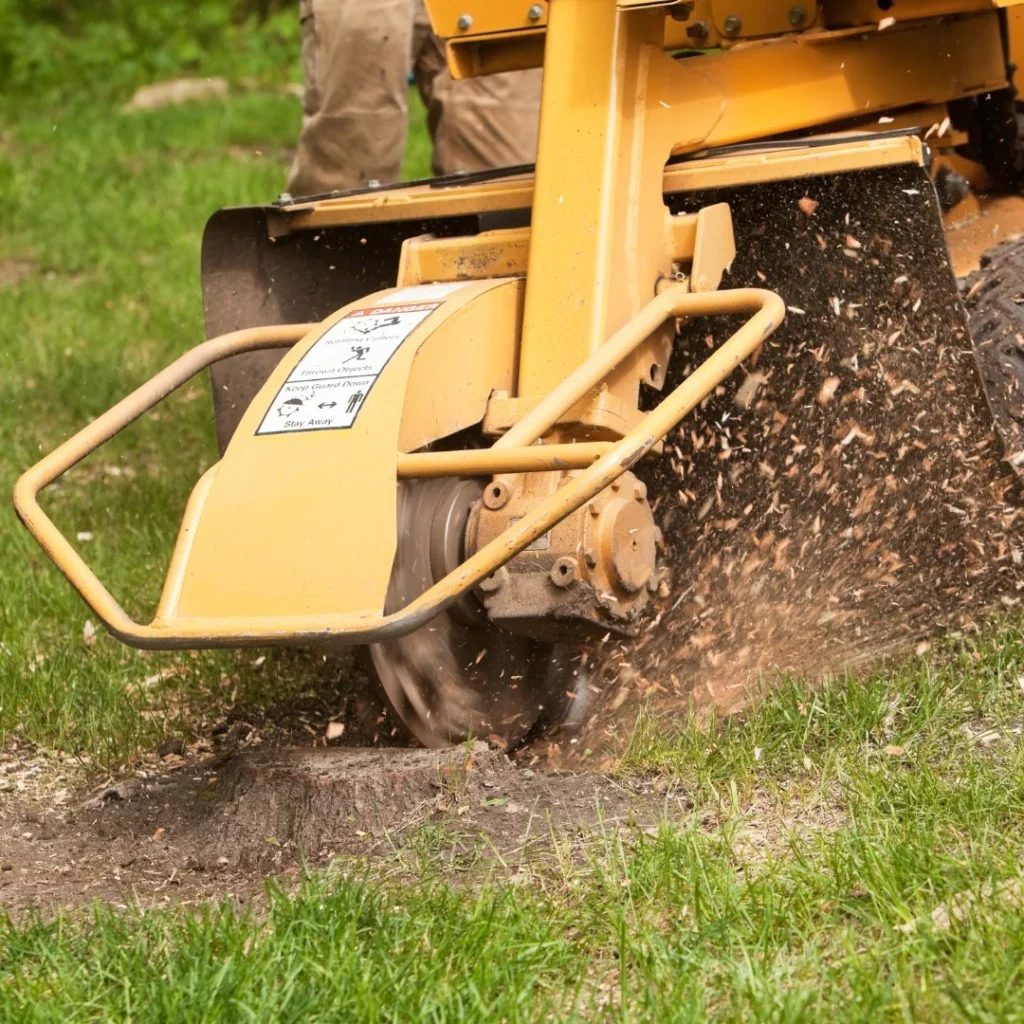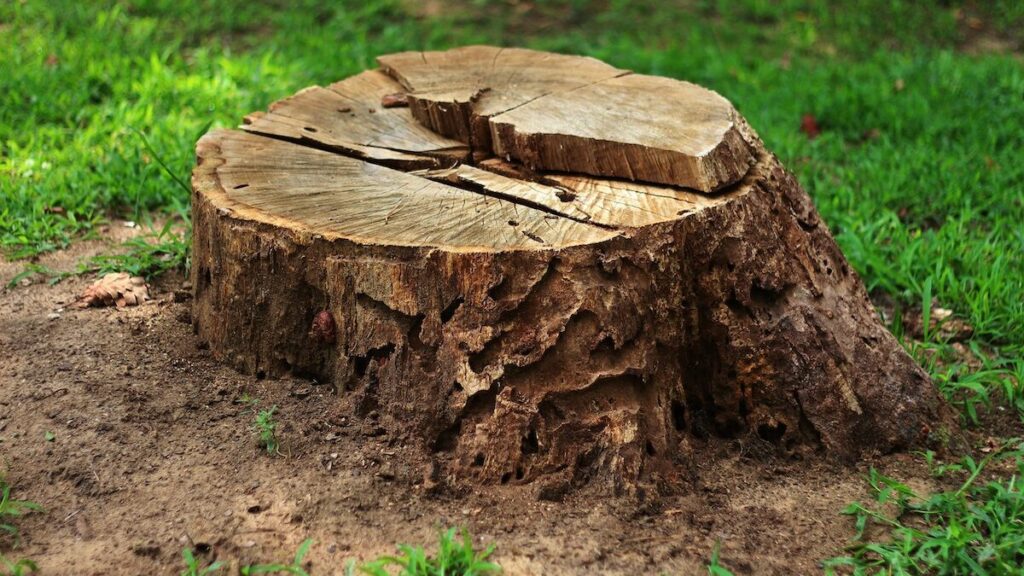If you have recently had a tree removed from your property and are left with an unsightly stump, you may be wondering about the best course of action to take. Stump grinding and stump removal are two common methods used to eliminate tree stumps, but which one is right for you? In this article, we will delve into the details of both methods and help you make an informed decision.
Understanding Stump Grinding
Stump grinding is a process that involves using a machine called a stump grinder to mechanically chip away at the stump until it is ground down below the surface of the soil. This method is effective in getting rid of the visible portion of the stump, while allowing the roots to naturally decay over time. But let’s dive deeper into the process and explore the pros and cons of stump grinding, as well as the cost and time considerations involved.
Both stump grinding and removal can pose safety hazards if not performed correctly. Stump grinding involves the use of heavy machinery, so it’s essential to hire a professional with the necessary skills and experience. The grinding equipment can kick up debris, so wearing protective gear is crucial during the process.

The Process of Stump Grinding
The stump grinding process typically begins with the removal of any rocks or debris around the stump. This ensures a clear working area for the stump grinder. Once the area is cleared, the stump grinder is then positioned above the stump, ready to unleash its grinding power. The grinding wheel, equipped with sharp teeth, is lowered onto the stump, gradually eating away at the wood.
As the operator carefully moves the grinder from side to side, layers of wood are systematically removed. The grinding continues until the stump is ground down to the desired depth. This process may take some time, depending on the size and hardness of the stump.
Pros and Cons of Stump Grinding
There are several advantages to choosing stump grinding over removal. Firstly, stump grinding is a less invasive method that does not require digging up the entire stump. This means minimal disruption to the surrounding landscape, preserving the beauty of your garden or yard.
Another benefit of stump grinding is that it allows you to retain the mulch produced during the process. This mulch can be used to enhance the fertility of your garden or as a natural landscaping material. It’s a sustainable way to repurpose the remnants of the stump. Learn more about fertility at https://www.nichd.nih.gov/health/topics/infertility
However, it’s important to note that stump grinding may not completely eliminate the roots. While the visible portion of the stump is effectively removed, there is a possibility of sprouts emerging from the remaining roots in the future. Regular monitoring and maintenance may be required to prevent new growth.
Cost and Time Considerations for Stump Grinding
When it comes to the cost of stump grinding, several factors come into play. The size of the stump and the accessibility of the site are key determinants. On average, you can expect to pay between $100 and $400 per stump. It’s advisable to get a few quotes from professional stump grinding services to ensure you are getting a fair price.
As for the time required, the duration of the stump grinding process depends on the size and complexity of the stump. A small stump can be ground down in just a few hours, while larger stumps may take several hours or even multiple days to complete. The expertise of the operator and the efficiency of the equipment also play a role in determining the overall time required.
So, if you have an unsightly stump in your yard that you want to get rid of, stump grinding is a viable option to consider. It’s a process that combines effectiveness, minimal disruption, and the potential for repurposing the resulting mulch. Just remember to weigh the pros and cons, and factor in the cost and time considerations before making your decision.
Delving into Stump Removal
Stump removal, on the other hand, involves completely uprooting the stump and its underlying root system from the ground. This method requires more labor and equipment compared to stump grinding. However, it can be the best option in certain situations.
The Procedure of Stump Removal
To remove a stump, the first step is typically to dig around the stump and expose the roots. This process requires precision and expertise to ensure that the roots are fully exposed without causing damage to the surrounding area. Once the roots are exposed, a mechanical or manual method is used to pull or pry the stump out of the ground.
When it comes to mechanical methods, there are various options available. One common method is to use a stump grinder to loosen the soil around the stump and then attach a winch or crane to pull the stump out. This method is effective for larger stumps or stumps with extensive root systems. Another mechanical method involves using a backhoe or excavator to dig around the stump and lift it out of the ground. This method is suitable for stumps in hard-to-reach areas or when dealing with multiple stumps. Click here to learn more about mechanical method.
For smaller stumps or stumps in delicate areas, manual methods may be employed. This can include using a shovel, pickaxe, or even an axe to dig around the stump and manually remove it. While this method requires more physical effort, it can be a more precise approach, minimizing potential damage to nearby structures or landscapes.
Advantages and Disadvantages of Stump Removal
One of the main advantages of stump removal is that it completely eliminates the stump, including the roots. This can be desirable if you want to reclaim the space for other landscaping purposes or prevent any potential regrowth. By removing the entire root system, you can ensure that the stump won’t sprout new shoots or cause any further issues.
However, stump removal is a more labor-intensive process that can result in significant disturbance to the surrounding area. The heavy machinery used in stump removal can cause damage to existing structures or landscapes if not handled properly. It is crucial to hire experienced professionals who can assess the situation and take the necessary precautions to minimize any potential risks.
Evaluating the Cost and Time for Stump Removal
Stump removal is generally more expensive than stump grinding due to the additional labor and equipment involved. The cost can range from $300 to $900 per stump, depending on various factors such as the size of the stump, the complexity of the removal, and the accessibility of the area. It is essential to obtain multiple quotes from reputable stump removal companies to ensure you are getting a fair price for the service.
In terms of time, stump removal can take anywhere from a few hours to a full day, depending on the complexity of the job. Factors such as the size and depth of the stump, the condition of the soil, and the presence of any obstacles or utilities can affect the duration of the removal process. It is important to discuss the timeline with the stump removal professionals to ensure that it aligns with your schedule and expectations.
When considering stump removal, it is crucial to weigh the advantages and disadvantages, as well as the cost and time involved. By understanding the procedure and evaluating the specific requirements of your situation, you can make an informed decision about the best method for removing stumps from your property.

Factors to Consider When Choosing Between Stump Grinding and Removal
When deciding between stump grinding and removal, there are a few key factors to take into account.
Tree stumps left in your yard can be more than just an eyesore; they can also attract pests and pose tripping hazards. Understanding the differences between stump grinding and removal can help you make an informed decision on the best course of action for your property.
Assessing the Condition of Your Stump
If the stump is relatively small and does not pose any immediate safety risks or aesthetic concerns, stump grinding may be the more practical and cost-effective option. However, if the stump is large, causing structural damage, or preventing new landscaping plans, stump removal may be the better choice.
It’s essential to consider the location of the stump as well. Stumps near buildings, walkways, or utility lines may require removal to prevent further damage or obstruction. On the other hand, stumps in remote areas of your property may be suitable for grinding without causing any issues.
Environmental Impact of Both Methods
From an environmental standpoint, stump grinding is considered to be more eco-friendly since it allows the roots to decay naturally, promoting soil health. The wood chips left behind after grinding can also be used as mulch to enrich the soil and suppress weed growth. In contrast, stump removal involves more invasive techniques that can disrupt the ecosystem of your yard.
When opting for stump removal, it’s important to consider the disposal of the stump and roots. Some tree service companies offer stump recycling services, where the wood is repurposed for mulch or other products, reducing waste and environmental impact.
Safety Concerns in Stump Grinding and Removal
Stump removal may require the use of tools such as chainsaws and digging equipment, which can be dangerous if mishandled. Additionally, the process of uprooting a stump can destabilize the surrounding soil, increasing the risk of accidents. Professional tree service providers are trained to assess potential risks and implement safety measures to protect both your property and themselves.
Frequently Asked Questions about Stump Grinding and Removal
Can I Do It Myself or Should I Hire a Professional?
While it is possible to rent stump grinders or attempt stump removal on your own, it is highly recommended to hire a professional for these tasks. Professionals have the expertise and specialized equipment to safely and efficiently complete the job, reducing the risk of accidents or damage to your property.
How Long Does Each Process Take?
The duration of both stump grinding and removal depends on various factors, such as the size and condition of the stump and the accessibility of the site. Generally, stump grinding can be completed within a few hours, while stump removal may take longer, typically ranging from a few hours to a full day.
What Happens After Stump Removal or Grinding?
After stump removal or grinding, you will be left with a hole or depression in the ground. It is important to fill this area with topsoil and compact it to level the ground. You may also choose to plant grass or other vegetation to restore the appearance of the area.
Ultimately, the choice between stump grinding and removal depends on your specific circumstances and preferences. Consider factors such as the size and condition of the stump, the environmental impact, and potential safety concerns when making your decision. Consulting with a professional tree service will ensure that you receive expert advice and quality service for the best outcome on your property.
Other resources: Comprehensive Tree Root Removal and Stump Grinding Services

